TLDR: Boerne startup goes ‘from design board to reality’ with novel wind turbine technology
Boerne-based wind energy startup, Wind Chaser, has developed a scalable and portable wind turbine that addresses the common issues faced by vertical-axis wind turbines. The turbine features a helix blade design that maximizes energy efficiency, and solves problems such as low energy generation in low winds and stalling in high winds. The turbine utilizes cylindrical blade ends called “cups” to minimize drag and maximize efficiency. The structure is made from recoverable and recyclable materials, and it is data-driven, load-bearing, and relocatable. Wind Chaser aims to launch its product commercially by the end of the summer.
Key Points:
- Boerne-based startup Wind Chaser has developed a scalable and portable wind turbine with a helix blade design
- The turbine addresses common issues faced by vertical-axis wind turbines and utilizes cylindrical blade ends to maximize efficiency
- The turbine is made from recoverable and recyclable materials and has applications in various industries, including oil and gas and military
- Wind Chaser plans a full commercial launch by the end of the summer
Article:
On an open field in Kendall County, a wind turbine more than five stories tall twists toward the sky. For a moment, the structure is a statue, as undisturbed as the land around it. But on a windy day like this, local entrepreneur Miles Murray knows that moment won’t last very long. “It’s a sight to see,” Murray said as the structure, propelled by a sudden gust of wind, begins to rotate. “I was pleasantly surprised when we put it together, because something going from a design board to reality is a very different thing.”
Murray is the founder of Wind Chaser, a wind energy startup based in Boerne. Over the past two years, he and his business partner have developed a scalable, portable wind turbine, designed for a variety of applications. Murray came up with the idea while enrolled in the University of Texas Master’s of Science and Technology Commercialization program. During his time in the program, he discovered that UT researchers were working on a helix blade design to maximize the energy efficiency of vertical-axis wind turbines.
One day, Murray was approached by a classmate who was interested in bringing the technology to market. “(He) did not have the partners, the access to networks and capital and the vision on how it turns into a full-developed product,” Murray recalled. “So that gentleman approached me, and about two years ago, we started collaborating on, ‘How do we turn this helix blade design into something that can be utilized in the real world?'”
The Wind Chaser turbine ranges from 45 to 85 feet tall, produces between 20 and 250 kilowatts per hour of energy, and solves two of the most common problems faced by vertical-axis wind turbines: Low energy generation in low winds and stalling in high winds, according to Murray. Wind Chaser solves these problems with its cylindrical blade ends, or “cups,” which minimize drag and maximize efficiency.
Besides its proprietary, helix blade design, there are several key differentiators between the Wind Chaser and other commercially-available wind turbines, according to Murray. For one, the Wind Chaser turbine is built from PVC pipes and lexan – materials which are both recoverable and recyclable. The structure is also data-driven, load-bearing and relocatable – making it particularly useful for the oil and gas industry, where a lack of transmission availability is a common problem faced by upstream oil producers, according to Wind Chaser.
Murray said the Wind Chaser can also be tied to existing wind farms, augmenting their wind capture capabilities. “There’s a lot of wind that’s being pushed downward as a result of those large towers, so if I were to have those large ones and then have one of my towers between each one, the wind that’s been coming off of those blades would be rotating these blades,” he said. “So, now you wind up really maximizing your square footage of your real estate for the purpose of generating wind power.”
Murray noted that there are also military applications for the technology. “You have a need to constantly send fuel trucks to military outposts, and a lot of times those are in contested regions, so they’re subject to be attacked. Not only does that create danger for the service member on the ground, it puts a real risk to the success of the operation,” Murray said. “These (turbines) are silent; they do not have a thermal trace, and you can put these up in areas where there is substantial enough wind and at least augment the power requirements that are needed.”
Wind Chaser is entirely self-funded, having raised $250,000 and $75,000 additional contributed capital to date through its investment firm, Bridgehead Capital Partners. While still in the proof of concept phase with its technology, Murray said the company is planning a full commercial launch by the end of the summer.
Putting Boerne on the map
Boerne, known historically for its farming and cattle ranching, is becoming a hotbed of innovation activity – in just the last few years, the region has brought up both Wind Chaser and woman-led startup Hera Biotech, which is developing an innovative, nonsurgical diagnostic test for endometriosis. A testament to its startup success, Boerne opened its first business incubator, Das GreenHaus in June. Launched through a collaboration between the Boerne Kendall County Economic Development Corp and Boerne Kendall County Angel Network, Das GreenHaus offers nearly 5,000 square feet of office space to tenants, along with mentorship, educational workshops and networking events.
Das GreenHaus Program Director Justin McKenzie and Murray have a shared vision of putting Boerne on the map for innovation, Murray said. Murray, who refers to himself as “half-scientist, half-entrepreneur,” is hopeful that by building partnerships, he will prove that today’s problems can be solved here, right in the heart of Hill Country. “I aim to help the Hill Country at large, all seven counties, be, along with Justin and Das GreenHaus, a place where you can come to find these companies and these entrepreneurs that traditionally have been hidden,” he said.









